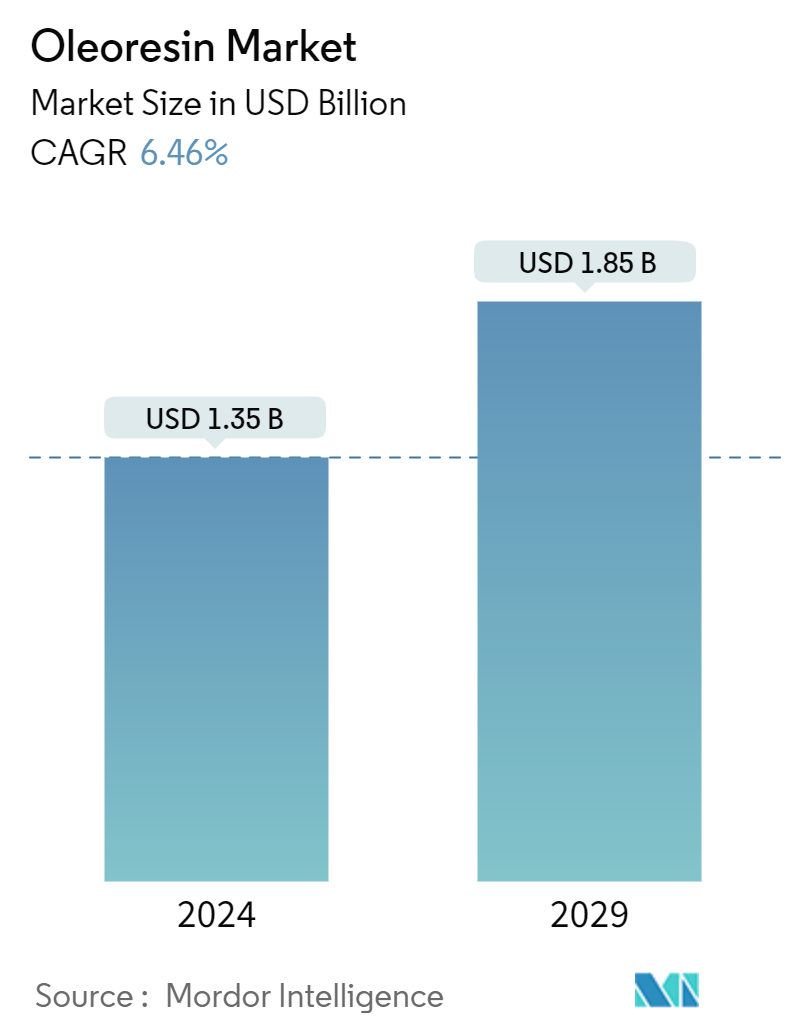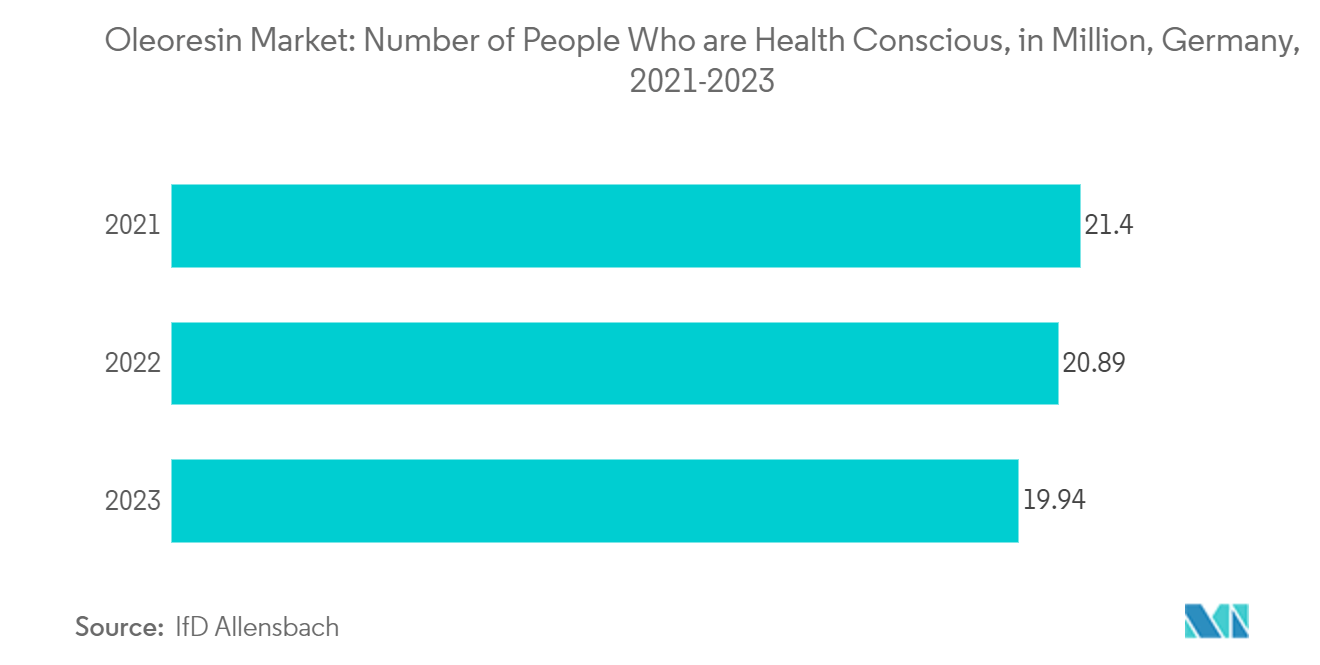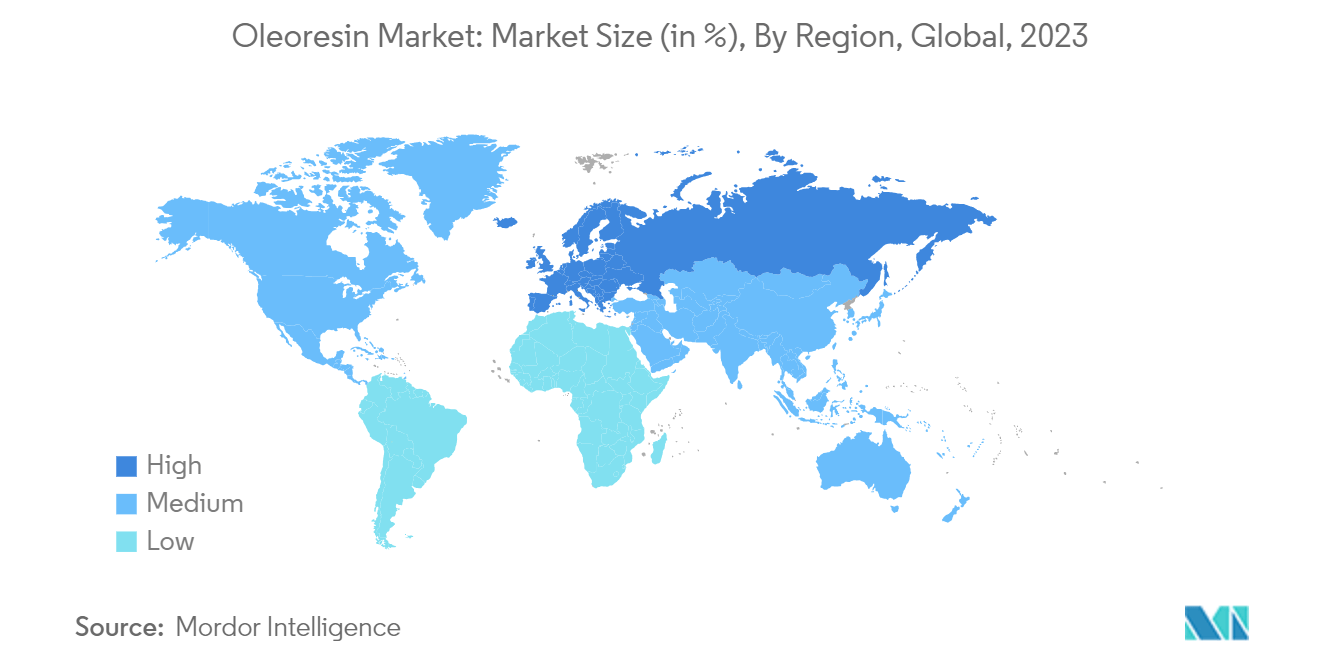
The Report Covers the Global Oleoresins Industry and is Segmented by Type (Paprika, Black Pepper, Turmeric, Capsicum, Ginger, and Other Product Types), by Application (Food and Beverage, Cosmetics and Personal Care, Pharmaceuticals and Others), and by Geography (North America, Europe, Asia-Pacific, South America, and Middle-East and Africa). The Report Offers the Market Size in Value Terms in USD for all the Abovementioned Segments.
Download Free PDF Now Table of Contents Download SampleSingle User License
Book before: 
.webp)
*Disclaimer: Major Players sorted in no particular order
Need a report that reflects how COVID-19 has impacted this market and its growth?
Download Free PDF
Single User License
Book before:The Oleoresin Market size is estimated at USD 1.35 billion in 2024, and is expected to reach USD 1.85 billion by 2029, growing at a CAGR of 6.46% during the forecast period (2024-2029).
Oleoresins are a naturally occurring combination of oil and resins that are heat-stable and easy to store. Since they are unsusceptible to microbiological contamination and have an extended shelf life compared to fresh or dried spices, the demand for oleoresins is increasing across various end-use industries. Moreover, there has been a considerable rise in the trend of natural and clean labeled flavors in processed food products. For instance, according to Ingredion’s study in 2023, around 78% of consumers globally are ready to pay extra for clean labels. Therefore, the demand for oleoresins is anticipated to escalate in the coming years.
Moreover, the growth of the food and beverage sector, particularly in emerging markets, fuels the demand for oleoresins as ingredients in processed foods, snacks, beverages, and others. Besides this, prominent players in the market focus on product innovation as a critical strategy to expand production and uphold market position. For instance, in 2023, GNT, a supplier of the Exberry line of plant-based food colors, launched a new orange color derived from paprika. The company claims that the Shade Vivid Orange–OS is a 100% oil-soluble, plant-based color made from non-GMO paprika in the firm’s Exberry portfolio. Such factors are likely to influence the demand for oleoresins from different sectors, such as food and beverage and pharmaceutical, during the study period.
Oleoresins are widely used as additives and coloring agents in the food and beverage industry to impart flavor, color, pungency, and aroma to packaged products. Moreover, they offer consistency in product quality, require less storage, and are cost-effective. Also, the availability of oleoresins throughout the year makes them an attractive substitute for various spices and seasoning ingredients. Oleoresin, a concentrated form of spices and herbs, has relatively large use in ethnic cuisine, which has multidimensional flavor and texture profiles owing to the significant use of spices, seasonings, and condiments. The rising popularity of ethnic cuisines, including Asian, Mexican, and Italian cuisine, especially in America and Europe, due to the increasing immigrant and ex-pat population, propels market growth. Apart from this, their consumption aid in alleviating various health conditions since oleoresins offer various functional properties, such as antioxidant, anti-inflammatory, antimicrobial, and anticancer.
Moreover, the growing focus on adopting a healthy lifestyle is driving individuals to incorporate nutritious and Ayurvedic spices into their diets. Additionally, consumers are becoming more cognizant of the significant advantages of integrating various oleoresins into their nutritional regimen, as it is renowned for its anti-inflammatory properties and its ability to regulate blood sugar levels. For instance, according to the International Diabetes Federation, the prevalence of diabetes is on the rise, with around 537 million adults aged 20-79 years living with the condition in 2021, and it is expected to escalate to 643 million by 2030. Therefore, an increase in the health-conscious population encourages consumers to opt for oleoresin-based edible products.

The increasing preference for clean-label ingredients over synthetic flavors and coloring agents drives the demand for oleoresins in cosmetics and food products in the United Kingdom. For instance, according to the data published by Ethical Consumer, the spending on ethical food and drink products amounted to approximately GBP 2.9 billion in the United Kingdom. Organic was the second-biggest category for consumer spending, of the total GBP 12.1 billion spent on products from various ethical categories.
Moreover, the robust food processing industry offers lucrative growth opportunities to oleoresin suppliers in Spain. For instance, according to the National Statistics Institute, INE, the turnover of the food and beverage industry in Spain amounted to EUR 130.795 billion in 2022, which represents 23.3% of the industrial sector in the country. In France, the demand for oleoresin is driven by the well-established cosmetic industry, which comprises more than 1300 cosmetic manufacturing companies as of 2024, according to the statistics reported by the ITA (The International Trade Administration). Annatto oleoresin, Ginger oleoresin, and Curcuma longa are primarily used oleoresins in the cosmetic industry as natural coloring agents. Its key applications are found in cosmetics ranging from lotions and creams to lipsticks, shampoos, lip balms, and hair colorants.

The global market for oleoresins is highly competitive, comprising regional and international players. Key players in the market include Synthite Industries Limited, Plant Lipids, Mane Group, Oterra A/S, and Kalsec Inc. The most adopted strategies of companies to acquire a significant market share remain offering a large variety of product formulations to consumers and constantly investing capital in upgrading and extending the products being offered. Also, product innovation is a favorable strategy companies prefer to strengthen their market dominance. Advanced distribution networks and manufacturing expertise give manufacturers an edge in expanding their range of products worldwide. The growing consumer preference for natural ingredients aligns well with the key players’ emphasis on natural oleoresin extraction. This focus positions them to capitalize on the rising demand for clean-label food and beverage products across the globe.
*Disclaimer: Major Players sorted in no particular order
Need More Details on Market Players and Competitors? Download PDFOleoresins are naturally extracted from various plants and can induce color, holistic taste, aroma, and texture. The main ingredients of oleoresin are pigments, pungent constituents, essential oils, fixed oils, and natural antioxidants. The global oleoresin market is segmented into type, application, and geography. By product type, the market is segmented into paprika, black pepper, turmeric, capsicum, ginger, and other product types. By application, the market has been segmented into food and beverage, pharmaceuticals, cosmetics and personal care, and others. The food and beverage segment is further classified into bakery goods, spices and condiments, meat and seafood products, and others. By geography, the study provides key insights into the major regions, including North America, Europe, Asia-Pacific, South America, and the Middle East & Africa. The market sizing has been done in value terms in USD for all the abovementioned segments.
| By Type |
| Paprika |
| Black Pepper |
| Turmeric |
| Capsicum |
| Ginger |
| Other Product Types |
| Food and Beverage |
| Bakery Goods |
| Spices and Condiments |
| Meat and Seafood Products |
| Other Food and Beverages |
| North America |
| United States |
| Canada |
| Mexico |
| Rest of North America |
| Europe |
| Spain |
| United Kingdom |
| France |
| Germany |
| Russia |
| Italy |
| Rest of Europe |
| Asia-Pacific |
| China |
| Japan |
| India |
| Australia |
| Rest of Asia-Pacific |
| South America |
| Brazil |
| Argentina |
| Rest of South America |